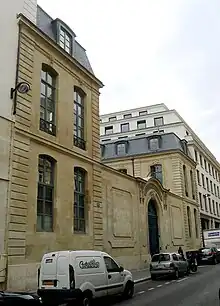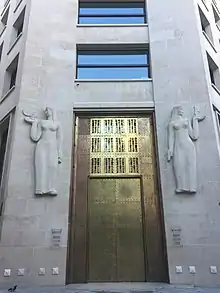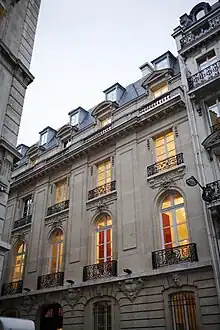Groupe BPCE
Groupe BPCE (for Banque Populaire Caisse d'Epargne) is a major French banking group formed by the 2009 merger of two major retail banking groups, Groupe Caisse d'Épargne and Groupe Banque Populaire. As of 2021, it was France's fourth largest bank, the seventh largest in Europe, and the nineteenth in the world by total assets.[6] It has more than 8,200 branches nationwide under their respective brand names serving nearly 150 million customers.[7] It is Europe's largest bank by revenue, ahead of BNP Paribas and HSBC. It is considered a global systemically important bank (G-SIB) by the Financial Stability Board.
 | |
 | |
| Type | Private. Cooperative |
|---|---|
| Industry | Financial services |
| Founded | 31 July 2009 |
| Headquarters | Paris , France |
Key people | Nicolas Namias, CEO of BPCE; Stephanie Paix, CEO of Natixis |
| Products | Banking and insurance |
| Revenue | US$47.9 billion (2019)[2] |
| 4,003,000,000 euro (2021) | |
| AUM | |
| Total assets | |
Number of employees | 220,000 (2022)[2] |
| Website | www.bpce.fr |
Background
Caisses d'Épargne, Eulia and Ixis
Groupe Caisse d'Épargne ("Savings Bank Group") was born in 1818 with the foundation of the Paris savings bank, Caisse d'Épargne et de Prévoyance de Paris. It long grew from the bottom up as an expanding set of local savings banks, until a 1983 legislation created a central financial entity or "national center", the Centre national des caisses d'épargne et de prévoyance (CENCEP). In 1992, CENCEP was replaced by the Caisse Nationale des Caisses d'Épargne (CNCE), which unlike CENCEP was a licensed bank. In 1999, new legislation transformed the savings banks into cooperatives. These developments paved the way for the gradual transformation of the decentralized network of savings banks into an increasingly integrated universal banking group in the next decade.
In July 1999, CNCE acquired majority ownership of Crédit Foncier de France. Also in 1999, France's Caisse des dépôts et consignations (CDC) formed a commercial and investment banking subsidiary, CDC IXIS. In 2001, CNCE and CDC formed a joint venture, Eulia, to which CDC contributed CDC IXIS. In June 2004, CNCE took full control of Eulia and therefore also of CDC IXIS, which it renamed Ixis. Between 2003 and 2008 CNCE separately acquired the French subsidiary of Sanpaolo IMI, including the former Banque Vernes and French operations of the Banque Française Commerciale, and made it its private banking subsidiary under the new brand Banque Palatine adopted in June 2005.
Banques Populaires and Natexis
Groupe Banque Populaire ("People's Bank Group") was created in 1878 with the foundation of the first local Popular Bank (French: banque populaire) in the western French city of Angers. In 1917, new legislation established the local Popular Banks' cooperative status and in 1921, another legislative act established a central financial entity, the Caisse centrale des Banques populaires (CCBP).
In 1919, the French state sponsored the creation of Crédit National, a specialized bank. In 1946, the French state created Compagnie Française d'Assurance pour le Commerce Extérieur (Coface), a trade credit insurer, and Banque Française du Commerce Extérieur (BFCE), a specialized bank providing export financing services. In 1996, Crédit National purchased BFCE, and the merged entity renamed itself as Natexis, in which natex is a portmanteau of national and extérieur.
The CCBP purchased Natexis in 1998, and renamed it Natexis Banques Populaires. In 1999, the CCBP was replaced by a new banking entity, the Banque fédérale des banques populaires (BFBP). Natexis Banques Populaires purchased Coface in 2002. That same year, cooperative bank the Crédit coopératif joined the Banque Populaire network.
Natixis
In 2006 the two groups, Caisse d'Épargne and Banque Populaire, agreed to merge their commercial and investment banking subsidiaries, respectively Ixis and Natexis Banques Populaires. The new entity was given the name Natixis, a portmanteau of Natexis and Ixis. Natixis went through an initial public offering on 25 October 2006, after which CNCE and BFBP each owned 35 percent of its equity capital, the rest being free float.
Natixis, however, soon suffered from poor capital allocation and risk management choices in the context of the Financial crisis of 2007–2008, including on investments into Bernie Madoff's funds. Key executives had to resign or were sacked: Nicolas Mérindol and Charles Milhaud, respectively CEO and chairman of CNCE, on 19 October 2008;[8] Bernard Comolet and Bruno Mettling, respectively chairman of Natixis and CEO of BFBP, on 6 March 2009;[9] and Dominique Ferrero, CEO of Natexis, on 29 April 2009.[10]
![Hôtel Bullion [fr], seat of the Caisse d'Épargne de Paris from 1844](../I/P1200666_Paris_Ier_hotel_Bullion_rwk.jpg.webp) Hôtel Bullion, seat of the Caisse d'Épargne de Paris from 1844
Hôtel Bullion, seat of the Caisse d'Épargne de Paris from 1844 Former head office of Crédit Foncier at 19, rue des Capucines
Former head office of Crédit Foncier at 19, rue des Capucines Entrance of the building at 115, rue Montmartre in Paris, former head office of Caisse Centrale des Banques Populaires
Entrance of the building at 115, rue Montmartre in Paris, former head office of Caisse Centrale des Banques Populaires Former head office of Crédit National at 45–47, rue Saint-Dominique in Paris
Former head office of Crédit National at 45–47, rue Saint-Dominique in Paris Former head office of Banque Française du Commerce Extérieur at 21, boulevard Haussmann in Paris
Former head office of Banque Française du Commerce Extérieur at 21, boulevard Haussmann in Paris Hotel de Richepanse at 3–5, rue Masseran, former head office of CENCEP, CNCE and Eulia
Hotel de Richepanse at 3–5, rue Masseran, former head office of CENCEP, CNCE and Eulia Le Ponant building in Paris, former head office of Banque Fédérale des Banques Populaires
Le Ponant building in Paris, former head office of Banque Fédérale des Banques Populaires Head office of Natixis in 2007, near the Gare de Lyon
Head office of Natixis in 2007, near the Gare de Lyon Former seat of Schneider et Cie at 42, rue d'Anjou in Paris, since December 2007 head office of Banque Palatine
Former seat of Schneider et Cie at 42, rue d'Anjou in Paris, since December 2007 head office of Banque Palatine
Creation of BPCE and subsequent developments


In 2008 and early 2009, the French state provided around 7 billion euros of financial support to the group formed by Caisse d'Épargne, Banque Populaire and Natixis. François Pérol, a senior aide to President Nicolas Sarkozy, led the decision-making on the group's restructuring. The entity resulting from the merger of CNCE and BFBP, named BPCE, was formed on 31 July 2009. That same day, Pérol became its CEO while Philippe Dupont, previously the chairman of Groupe Banque Populaire, became non-executive chairman of BPCE.
In 2014, BPCE had Coface listed through an initial public offering, and subsequently reduced its equity stake. As of March 2021, BPCE retained residual ownership of 12.7 percent of Coface's capital.
In July 2016, BPCE announced the purchase of Fidor Bank, a Fintech challenger bank, operating in the UK and Germany,[11] but in November 2018 considered selling it again.[12]
In 2018–2019, BPCE fully integrated the former Crédit Foncier de France's activities into its other operations and terminated the use of the Crédit Foncier brand. In June–July 2021, it acquired all shares of Natixis that it did not previously own, and completed the entity's delisting on 31 July 2021.
Leadership
Groupe BPCE has had three chief executives (French: président du directoire) so far:
- François Pérol (July 2009 - May 2018)
- Laurent Mignon (June 2018 – December 2022)
- Nicolas Namias (December 2022 – present)
Structure and operations
Despite the 2009 merger, the two networks of local banks, Caisse d'Épargne and Banque Populaire, continue to operate under separate and to an extent competing brands. BPCE is fully owned by local savings banks and popular banks, which in turn are legally owned by their customers as cooperative members.
BPCE provides various deposit and loan products to small and medium enterprises, craftspeople, franchisees, and franchisers; savings collection and management, credit, payment, and wealth management services; and real estate financing and corporate banking services. The company also offers bancassurance products, including life assurance and pensions that comprise automobile and home insurance,[13] legal protection, the guarantee of life accidents, the supplementary health care insurance, welfare professionals and the collective retirement pensions and health, as well as credit insurance and guarantees to individuals, professionals, real estate professionals, and businesses.[14]
Controversies
In 2010 the French government's competition authority, the Autorité de la concurrence, fined eleven banks, including Groupe BPCE, 385 million euros in the context of the French check processing fee controversy of 2010.[15][16]
In 2022, Groupe BPCE's subsidiary Natixis, which owns a property at the famous intersection of Haight and Ashbury Streets in San Francisco, is forcing legendary music venue Club DeLuxe, the nesting ground for Swing revival, to close its doors.[17]
References
- "Un nouveau siège en toutes lettres". Groupe BPCE. 24 March 2022.
- "Global 500".
- "assets under management at end-2022". groupebpce.fr. 31 December 2022.
- "assets under management at end-2022" (PDF). groupebpce.com. 31 December 2022. p. in PDF on Page 1.
- "The world's 100 largest banks, 2021". S&P Global Market Intelligence.
- "The world's 100 largest banks, 2021". S&P Global Market Intelligence.
- "Groupe BPCE Company Profile - Yahoo! Finance". cf.us.biz.yahoo.com. Archived from the original on 18 July 2011. Retrieved 14 August 2020.
- AFP (19 October 2008). "A la Caisse d'épargne, des demi-démissions". Libération.
- CercleFinance.com (6 March 2009). "Natixis : F. Pérol nommé président du conseil de surveillance". BFM Bourse.
- Laura Berny (30 April 2009). "Les têtes continuent de tomber dans les banques". Les Echos.
- "Home Insurance Index (2016)". www.finextra.com. 28 July 2016. Retrieved 12 October 2016.
- "BPCE and Fidor head for breakup". 12 November 2018.
- "Home Insurance Index (2016)". www.shiftins.com. Retrieved 12 July 2016.
- "Groupe BPCE: Private Company Information - BusinessWeek". investing.businessweek.com. Archived from the original on October 9, 2012. Retrieved 25 January 2011.
- Collusion in the banking sector, Press Release of Autorité de la concurrence, République Française, 20 September 2010, retrv 2010 9 20
- 3rd UPDATE: French Watchdog Fines 11 Banks For Fee Cartel , Elena Bertson, Dow Jones News Wires / Wall Street Journal online, retr 2010 9 20
- Woodliff, Abraham. "Club Deluxe is Closing". Broke Ass Stuart. Broke Ass Stuart. Retrieved 3 August 2022.